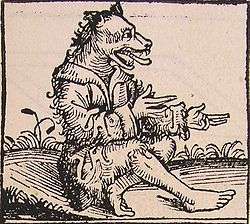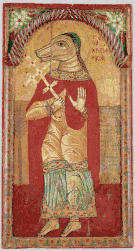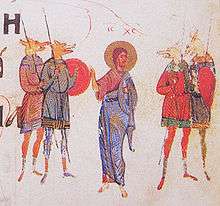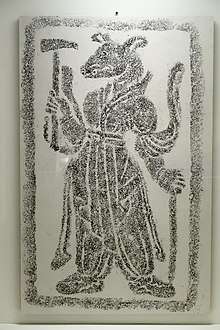Cynocephaly
The characteristic of cynocephaly, or cynocephalus (/saɪnoʊˈsɛfəli/), having the head of a dog—or of a jackal—is a widely attested mythical phenomenon existing in many different forms and contexts. The literal meaning of "cynocephaly" is "dog-headed"; however, that this refers to a human body with a dog head is implied. Such cynocephalics are known in mythology and legend from many parts of the world, including ancient Egypt, Greece, and China. Further mentions come from the medieval East and Europe. In modern popular culture cynocephalics are also encountered as characters in books, comics, and graphic novels. Cynocephaly is generally distinguished from lycanthropy (werewolfism) and dogs that can talk.

Etymology
The word cynocephaly is taken (through Latin) from the Greek word κυνοκέφαλοι kynokephaloi, plural of the word κυνοκέφαλος,[1] from kyno– (combining form of κύων kyōn) meaning "dog" and κεφαλή kephalē meaning "head".
The same "dog" root is found in the name Cynomorpha ("dog-shaped") for a sub-group of the family Cercopithecidae, which contains many species of macaques and baboons.
Ancient Greece and Egypt
Cynocephaly was familiar to the ancient Greeks from representations of the Egyptian gods, Duamutef (Son of Horus), Wepwawet (The opener of the ways), and Anubis (the Egyptian god of the dead). The Greek word (Greek: κῠνοκέφᾰλοι) "dog-head" also identified a sacred Egyptian baboon with the face of a dog.[2]
Reports of dog-headed races can also be traced back to Greek antiquity. In the fifth century BC, the Greek physician Ctesias, in his Indica, wrote a detailed report on the existence of cynocephali in India.[3] Similarly, the Greek traveller Megasthenes claimed to know about dog-headed people in India who lived in the mountains, communicated through barking, wore the skins of wild animals and lived by hunting.[4] Herodotus reports claims by ancient Libyans that such creatures inhabit the east of their lands, as well as headless men and various other anomalies.[5]
The best estimate for the place where the battle between the Argonauts and the Cynocephali took place is modern day North Serbia, or South Hungary.[6]
Late Antiquity
The cynocephali offered such an evocative image of the magic and brutality deemed characteristic of bizarre people of distant places that they kept returning in medieval literature. St. Augustine of Hippo mentioned the cynocephali in The City of God, Book XVI, Chapter 8, in the context of discussing whether such beings were descendants of Adam; he considered the possibility that they might not exist at all, or might not be human (which Augustine defines as being a mortal and rational animal: homo, id est animal rationale mortale), but insisted that if they were human they were indeed descendants of Adam.[7]
Medieval East
Cynocephali also figure in medieval Christian worldviews. A legend that placed Andrew the Apostle and Bartholomew the Apostle among the Parthians presented the case of "Abominable", the citizen of the "city of cannibals... whose face was like unto that of a dog." After receiving baptism, however, he was released from his doggish aspect.[8]
Saint Christopher

In the Eastern Orthodox Church, certain icons covertly identify Saint Christopher with the head of a dog. The background to the dog-headed Christopher is laid in the reign of the Emperor Diocletian, when a man named Reprebus, Rebrebus or Reprobus (the "reprobate" or "scoundrel") was captured in combat against tribes dwelling to the west of Egypt in Cyrenaica. To the unit of soldiers, according to the hagiographic narrative, was assigned the name numerus Marmaritarum or "Unit of the Marmaritae", which suggests an otherwise-unidentified "Marmaritae" (perhaps the same as the Marmaricae Berber tribe of Cyrenaica). He was reported to be of enormous size, with the head of a dog instead of a man, apparently a characteristic of the Marmaritae. This Byzantine depiction of St. Christopher as dog-headed resulted from their misinterpretation of the Latin term Cananeus (Canaanite) to read canineus, that is, "canine".[9]
The German bishop and poet Walter of Speyer portrayed St. Christopher as a giant of a cynocephalic species in the land of the Chananeans (Canaan in the New Testament) who ate human flesh and barked. Eventually, Christopher met the Christ child, regretted his former behavior, and received baptism. He, too, was rewarded with a human appearance, whereupon he devoted his life to Christian service and became an Athleta Christi, one of the military saints.[10] There are some rare icons that depict this martyr with the head of a dog. Such images may carry echoes of the Egyptian dog-headed god, Anubis. Christopher pictured with a dog's head is not generally supported by the Orthodox Church, as the icon was proscribed in the 18th century by Moscow.[11]
Ibn Battuta
Ibn Battuta encountered dog-mouthed people on his journey, in an island somewhere between India and Sumatra:[12]
Fifteen days after leaving Sunaridwan we reached the country of the Barahnakar, whose mouths are like those of dogs. This tribe is a rabble, professing neither the religion of the Hindus nor any other. They live in reed huts roofed with grasses on the seashore, and have abundant banana, areca, and betel trees. Their men are shaped like ourselves, except that their mouths are shaped like those of dogs; this is not the case with their womenfolk, however, who are endowed with surpassing beauty. Their men too go unclothed, not even hiding their nakedness, except occasionally for an ornamental pouch of reeds suspended from their waist. The women wear aprons of leaves of trees. With them reside a number of Muslims from Bengal and Sumatra, who occupy a separate quarter. The natives do all their trafficking with the merchants on the shore, and bring them water on elephants, because the water is at some distance from the coast and they will not let the merchants go to draw it for themselves, fearing for their women because they make advances to well-formed men. Elephants are numerous in their land, but no one may dispose of them except the sultan, from whom they are bought in exchange for woven stuffs.
— Ibn Battuta
Medieval West

Paul the Deacon mentions cynocephali in his Historia gentis Langobardorum: "They pretend that they have in their camps Cynocephali, that is, men with dogs' heads. They spread the rumor among the enemy that these men wage war obstinately, drink human blood and quaff their own gore if they cannot reach the foe."[13] At the court of Charlemagne, the Norse were given this attribution, implying un-Christian and less-than-human qualities: "I am greatly saddened" said the King of the Franks, in Notker's Life, "that I have not been thought worthy to let my Christian hand sport with these dog-heads."[14] The ninth-century Frankish theologian Ratramnus wrote a letter, the Epistola de Cynocephalis, on whether the Cynocephali should be considered human (he thought that they were).[15] If human, a Christian's duty would be to preach the Gospels to them. If animals, and thus without souls, such would be pointless. Quoting St. Jerome, Thomas of Cantimpré corroborated the existence of Cynocephali in his Liber de Monstruosis Hominibus Orientis, xiv, ("Book of Monstrous men of the Orient"). The thirteenth-century encyclopedist Vincent of Beauvais acquainted his patron Saint Louis IX of France with "an animal with the head of the dog but with all other members of human appearance… Though he behaves like a man… and, when peaceful, he is tender like a man, when furious, he becomes cruel and retaliates on humankind".[16]
The Nowell Codex, perhaps more commonly known as the manuscript containing the Anglo-Saxon epic Beowulf, also contains references to Cynocephali. One such reference can be found in the part of the manuscript known as The Wonders of the East, in which they are called "healfhundingas" or "half-dogs." Also, in Anglo-Saxon England, the Old English word wulfes heafod ("wolf's head") was a technical term for an outlaw, who could be killed as if he were a wolf. The so-called Leges Edwardi Confessoris, written around 1140, however, offered a somewhat literal interpretation: “[6.2a] For from the day of his outlawry he bears a wolf's head, which is called wluesheued by the English. [6.2b] And this sentence is the same for all outlaws.”[17] Cynocephali appear in the Old Welsh poem Pa Gur? as cinbin (dogheads). Here they are enemies of King Arthur's retinue; Arthur's men fight them in the mountains of Eidyn (Edinburgh), and hundreds of them fall at the hand of Arthur's warrior Bedwyr (later known as Bedivere).[18] The next lines of the poem also mention a fight with a character named Garwlwyd (Rough-Gray); a Gwrgi Garwlwyd (Man-Dog Rough-Gray) appears in one of the Welsh Triads, where he is described in such a way that scholars have discussed him as a werewolf.[19][20]
High and late medieval travel literature
.png)
Medieval travellers Giovanni da Pian del Carpine and Marco Polo both mention cynocephali. Giovanni writes of the armies of Ögedei Khan who encounter a race of dogheads who live north of the Dalai-Nor (Northern Ocean), or Lake Baikal.[21] The Travels of Marco Polo mentions the dog-headed barbarians on the island of Angamanain, or the Andaman Islands.[22] For Polo, although these people grow spices, they are nonetheless cruel and "are all just like big mastiff dogs".[23] In The Voyage and Travels of Sir John Mandeville, dog-headed men are described as inhabiting the island of Nacumera (the Nicobar Islands).[22]
According to Henri Cordier, the source of all the fables of the dog-headed barbarians, whether European, Arabic, or Chinese, can be found in the Alexander Romance.[24]
Modern European
In his feature Giant Egg, David Attenborough speculates that the indri, a type of lemur from Madagascar, may be one possible origin to the myth of dog-headed men.[25]
China

In Central and East Asia a common calendar system consists of a twelve-year cycle, with each year represented as an animal. The eleventh animal of the twelve-year cycle is the dog. Often such animals are depicted as human figures with an animal head. Thus, the cynocephalic depiction of the eleventh zodiac animal is common (possibly with a tail).
Additionally, in the Chinese record Book of Liang, the Buddhist missionary Huisheng describes an island of dog-headed men to the east of Fusang, a nation he visited variously identified as Japan or the Americas. The History of the Northern Dynasties of Li Dashi and his son, Li Yanshou, Tang historians, also mentions the "dog kingdom".
Modern appearances
The use of dog-headed, human-bodied characters is still very strong in modern literature. In the domain of comics publishing in North America and in Europe many works feature an "all-cynocephalic" cast or use the heads of dogs and other animals together for social comment or other purposes:
- In the Pulitzer Prize winning graphic novel Maus by Art Spiegelman, Jews have human bodies and the heads of mice while characters with their roots in the United States have human bodies and the heads of dogs, Germans have the heads of cats, and the French have the heads of frogs.
- The comic book Ghost Rider features a villain named Doghead. He is an anthropomorphic dog who serves Blackheart, the son of Mephisto, a demon lord falsely claiming to be The Devil.
- The hero of Baudolino, a novel by Umberto Eco, has to face dog-headed people at the end of his journey.
- Dog-headed creatures based on the ancient accounts appear in many modern role-playing games, such as Dungeons & Dragons.
- A fearsome race of dog-faced warriors appear in Terry Jones's book The Saga of Erik the Viking.
- The title character in Scott Adams' cartoon Dilbert once dated a dog-headed woman, described as "fetching".
- In the 1989 cult film Marquis by Henri Xhonneux, the Marquis de Sade is portrayed as a human with the head of a Spaniel.
- Mr. Peanutbutter, a major character in the Netflix comic psychodrama BoJack Horseman, is a cynocephalic person with the head and other characteristics of a Labrador Retriever.
- The Camp Half-Blood Chronicles feature the Cenocephaly (spelled as "Cynocephali").
- In The Heroes of Olympus book "The Blood of Olympus," the Cynocephali were obtained from Triumvirate Holdings by Octavius.
- In The Trials of Apollo book "The Tyrant's Tomb," the Cynocephali are among the monsters used in Caligula's attack on Camp Jupiter.
- In The Mummy Returns The Scorpion King leads an Army of Jackal Headed Warriors called the Army of Anubis also it is revealed that the only way to kill these creatures is through decapitation
Other dog-headed creatures in legend
- The Talmud states that at the time before the Messiah, the "face of the generation will have the face of a dog." Talmud, Sotah 49b; Talmud, Sanhedrin 97a[26]
- The Chinese legend of Fuxi included variations where he had a dog's head, or he and his sister Nüwa had ugly faces.
- In Saami mythology, according to Craig Chalquist, PhD, Padnakjunne ("Dog-Face") are cannibalistic humanoids with dog snouts.
- In the United States there are tales of dog-headed creatures, including the Michigan Dogman,[27] and the wolf-like Beast of Bray Road of Wisconsin.
- The Wulver of Shetland in Scotland.
- Psoglav in Serbian mythology.
- Itbarak in Turkic mythology
See also
- Ghouls and Qutrubs sharing same origin of myth
- Theriocephaly, generic term for human-shaped bodies with animal heads
- Ulfheðnar, wolf-associated berserkers
- Werewolves, which figure in archaic Greek and other European traditions.
- Furry fandom, present day cynocephalysophic subculture
Notes
- Diodorus Siculus, Library, 3.35.5
- The binomial name for the yellow baboon is Papio cynocephalus, while Cynocephalus has also been adopted as the genus name for an Asian arboreal gliding mammal also known as a colugo.
- Ctesias, Indica §§ 37, 40–3
- Megasthenes, Indica, vis-a-vis Pliny the Elder, Historia Naturalis 7.2: 14–22; Fragments XXX. B. Solin. 52. 26–30.
- Herodotus. The Histories. translated by A. D. Godley. 4.191.
- The Expedition of the Argonauts.
- Augustine of Hippo, City of God, Book XVI, Chapter 8
- David Gordon White, Myths of the Dog-man (University of Chicago Press) 1991:32.
- Ross, L. (1996). Medieval Art: A Topical Dictionary. Westport. p. 50.
- Walter of Speyer, Vita et passio sancti Christopher martyris, 75.
- Pageau, Jonathan. "Understanding The Dog-Headed Icon of St-Christopher", Orthodox Arts Journal, July 8, 2013
- Bontekoe, Willem (1929). Travels in Asia and Africa 1325-1354 by Ibn Battuta. London: George Routledge and Sons.
- simulant se in castris suis habere cynocephalos, id est canini capitis homines. Divulgant apud hostes, hos pertinaciter bella gerere, humanum sanguinem bibere et, si hostem adsequi non possint, proprium potare cruorum. Paul the Deacon, Historia gentis Langobardorum Book 1, ch. 11.
- Notker, Life of Charlemagne, Book II §3.
- Patrologia Latina 121: 1153–56.
- Vincent, Speculum naturale, 31:126.
- lupinum enim caput geret a die utlagacionis sue, quod ab Anglis 'uuluesheued' [= Old English wulfes heafod 'wolf's head'] nominatur. Et haec sententia communis est de omnibus utlagis. Leges Edwardi Confessoris § 6.
- Green, p. 84-85.
- Bromwich, p. 73–74
- Bromwich p. 385
- John of Plano Carpini, The long and wonderful voyage of Frier Iohn de Plano Carpini, Chapters 11 and 15
- Hulme, F. Edward (Frederick Edward) (1895). Natural history, lore and legend; being some few examples of quaint and by-gone beliefs, gathered in from divers authorities, ancient and mediaeval, of varying degrees of reliability. Robarts – University of Toronto. London B. Quaritch. pp. 72–73.
- Yule, Henry and Cordier, Henri. The Travels of Marco Polo, Chapter 13, Vol II
- Henri Cordier's 'Notes and Addenda' in the Sir Henry Yule edition of The Travels of Marco Polo, Volume 2.
- "Attenborough and the Giant Egg". 2 March 2011 – via www.imdb.com.
- Talmud, Sotah 49b; Talmud, Sanhedrin 97a
- Godfrey, Linda S. (2003). The Beast of Bray Road: Tailing Wisconsin's Werewolf. Big Earth Publishing. pp. 58–61. ISBN 1-879483-91-2. Retrieved 14 October 2010.
References
- Bromwich, Rachel (2006). Trioedd Ynys Prydein: The Triads of the Island of Britain. University Of Wales Press. ISBN 0-7083-1386-8.
- Ctesias, Indica, as excerpted by Photios in his Epitome, tr. J.H. Freese, available from Livius.org.
- Green, Thomas (2007). Concepts of Arthur. Stroud, Gloucestershire: Tempus. ISBN 978-0-7524-4461-1.
- Megasthenes, Indica, tr. J.W. McCrindle, Ancient India as Described by Megasthenes and Arrian. Calcutta and Bombay: Thacker, Spink, 1877. 30-174, available from Project South Asia
- Paul the Deacon, Historia gentis Langobardorum ("History of the Lombards"), ed. L. Bethmann and G. Waitz, "Pauli historia Langobardorum." In MGH Scriptores rerum Langobardicarum et Italicarum 1 (saec. VI-IX), ed. G. Waitz. Hanover, 1878. 12-187; tr. Foulke, W.D. History of the Langobards. Univ. of Pennsylvania, 1907. Available from Northvegr.
- Leges Edwardi Confessoris, ed. and tr. Bruce R. O'Brien, God's peace and king's peace: the laws of Edward the Confessor. Philadelphia: Univ. of Pennsylvania Press, 1999. ISBN 0-8122-3461-8.
External links
| Wikimedia Commons has media related to Cynocephali. |
- Anthony Weir, "A holy dog and a dog-headed saint": St Guinefort and St Christopher Cynephoros or Cynocephalus
- Christopher Columbus & the Monstrous Races